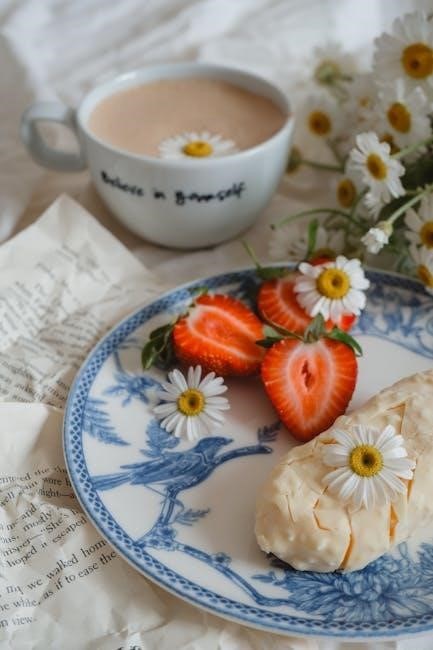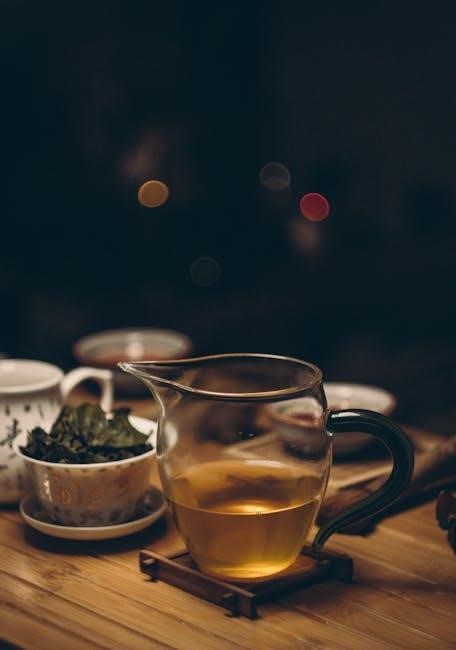herbal tea guide
Summary
Explore the world of herbal tea with our comprehensive guide. Learn about benefits, recipes, and more to enhance your wellness journey!

Herbal tea, also known as tisane, is a centuries-old beverage made from infusions of fruits, flowers, herbs, and spices․ It offers a flavorful and healthy alternative to traditional tea, promoting wellness and relaxation while showcasing diverse cultural traditions worldwide․
What is Herbal Tea?
Herbal tea, also known as tisane, is a type of tea that is not made from the leaves of the Camellia sinensis plant, which is used to make black, green, white, and oolong teas․ Instead, it is made from the infusion of fruits, flowers, herbs, and spices․ Popular examples include peppermint, chamomile, hibiscus, and rosehip teas․ These teas are often consumed for their potential health benefits, such as aiding digestion, promoting relaxation, and boosting the immune system․ Unlike traditional teas, most herbal teas are caffeine-free, making them a popular choice for those who want to avoid caffeine or enjoy a soothing, non-stimulating beverage․ Herbal teas can be enjoyed hot or iced, sweetened or unsweetened, and their flavors range from floral to fruity to spicy․ They are widely enjoyed worldwide for their unique flavors and potential health benefits․
History and Cultural Significance
Herbal teas have a rich history that dates back thousands of years, with roots in ancient civilizations such as Egypt, China, and Greece․ These teas were often used for medicinal purposes, spiritual rituals, and social gatherings․ In traditional Chinese medicine, herbal infusions were prescribed for their healing properties, while in Europe, they were consumed as folklore remedies․ Many cultures revered herbal teas for their flavor and health benefits, incorporating them into daily life and ceremonies․ The use of herbs like chamomile, mint, and hibiscus has been passed down through generations, reflecting their enduring popularity․ Today, herbal teas continue to play a significant role in global culture, offering a bridge between ancient traditions and modern wellness practices․
Popular Types of Herbal Tea

Herbal teas come in a wide variety, each offering unique flavors and benefits․ Chamomile tea is renowned for its calming effects, while peppermint tea is prized for its refreshing aroma and digestive aid․ Hibiscus tea, known as “Agua de Jamaica,” is a fruity, vitamin C-rich infusion․ Ginger tea is celebrated for its spicy warmth and anti-inflammatory properties․ Rooibos tea, a caffeine-free option from South Africa, is cherished for its nutty flavor and antioxidant content․ These teas, among others, have gained global popularity for their taste and health-enhancing qualities, making them a delightful choice for those seeking a soothing, natural beverage․
Health Benefits of Herbal Tea

Herbal teas are packed with antioxidants, promoting relaxation, boosting the immune system, and offering natural remedies for common ailments, enhancing overall well-being․
Common Health Benefits

Herbal teas are renowned for their wide array of health benefits, largely due to their high antioxidant content․ They aid in boosting the immune system, improving digestion, and reducing stress․ Many herbal teas, such as peppermint and chamomile, are natural remedies for relaxation and sleep improvement; Others, like ginger and turmeric tea, are known for their anti-inflammatory properties․ Hibiscus tea is often consumed to help lower blood pressure, while green tea is celebrated for its weight management and detoxifying effects․ The holistic approach of herbal teas makes them a popular choice for those seeking natural health solutions without harsh chemicals or side effects․ With their diverse flavors and numerous benefits, herbal teas are a delightful way to enhance overall well-being․
Herbal Teas for Specific Health Conditions
Herbal teas are often tailored to address specific health concerns, offering natural solutions for various ailments․ Chamomile tea is widely used to alleviate anxiety and insomnia, while peppermint tea is known to ease digestive issues like bloating and indigestion․ Ginger tea is a popular remedy for nausea and inflammation, making it ideal for those with arthritis or undergoing chemotherapy․ Echinacea tea is often consumed to boost the immune system and reduce the severity of colds and flu․ Hibiscus tea has been shown to help lower blood pressure, benefiting cardiovascular health․ Additionally, dandelion tea is used for liver detoxification, and lemon balm tea is known for its calming effects and ability to reduce stress․ Each herbal tea is uniquely suited to target specific health conditions, providing tailored benefits for overall wellness․
Nutritional Value and Antioxidants
Herbal teas are rich in essential nutrients and antioxidants, making them a healthy addition to a balanced diet․ Many varieties contain vitamins like vitamin C, vitamin E, and B vitamins, along with minerals such as calcium, magnesium, and iron․ Antioxidants, including flavonoids and polyphenols, play a crucial role in protecting the body from oxidative stress and inflammation․ For instance, hibiscus tea is high in vitamin C and antioxidants, while chamomile tea contains apigenin, which has anti-inflammatory properties․ These teas also often include Phytochemicals that support immune function and overall well-being․ The absence of caffeine in most herbal teas makes them a great choice for those seeking a natural, rejuvenating beverage․ With their diverse nutrient profiles, herbal teas offer a delicious way to enhance health and vitality․

How to Prepare Herbal Tea
Herbal tea is prepared by steeping dried herbs in boiling water for 5-10 minutes․ Strain and enjoy with optional honey or lemon for enhanced flavor․

Basic Brewing Instructions
Brewing herbal tea is simple and rewarding․ Start by boiling fresh water and pouring it over your chosen herbs in a teapot․ Use one teaspoon of dried herbs or one tablespoon of fresh herbs per cup of water․ Allow the mixture to steep for 5 to 10 minutes, depending on the herb’s strength and your desired flavor․ Strain the tea into a cup using a tea infuser or a fine-mesh sieve․ For floral or delicate herbs, use shorter steeping times to avoid bitterness․ Optionally, add honey or lemon for flavor․ Experiment with different herbs and steeping times to find your perfect cup․ This method ensures a flavorful and aromatic herbal tea experience․
Tools and Equipment Needed
To prepare herbal tea, you’ll need a few essential tools․ Start with a clean teapot, preferably made of glass, ceramic, or stainless steel, to preserve the tea’s flavor․ A tea infuser or strainer is useful for containing loose herbs, making it easy to steep and remove them․ A kettle is necessary for boiling water to the ideal temperature․ For precise measurements, use a teaspoon or tablespoon, depending on the herb quantity․ A fine-mesh sieve or piece of cheesecloth can strain the tea if you don’t have an infuser․ Optional items include a timer for steeping and a mug for serving․ These tools ensure a seamless and enjoyable brewing process, allowing you to fully appreciate the flavors and benefits of your herbal tea․
Recommended Steeping Times and Temperatures
The ideal steeping time and temperature for herbal tea vary depending on the type of herbs used․ Generally, most herbal teas require water at a rolling boil (around 200°F to 212°F) and a steeping time of 5 to 7 minutes․ Delicate herbs like chamomile or lemon balm may need shorter steeping times (3 to 5 minutes) to avoid bitterness, while heartier herbs like ginger or dandelion root can steep for 8 to 10 minutes․ Adjust the temperature slightly for floral or fruit-based teas, using water just below boiling (190°F to 200°F)․ Always consider the specific instructions for the blend you’re using, as some herbs may require unique preparation․ Experimenting with steeping times and temperatures can help you achieve the perfect balance of flavor and potency in your herbal tea․

Safety and Precautions
Herbal teas are generally safe, but consult healthcare professionals before use, especially for pregnant individuals, those on medication, or with allergies․ Avoid overconsumption․
Potential Allergies and Interactions
Potential Allergies and Interactions

Herbal teas, while generally safe, can cause allergic reactions or interact with medications․ Certain herbs, like ragweed or chamomile, may trigger allergies in sensitive individuals․ Additionally, some teas, such as those containing St․ John’s Wort or ginkgo biloba, may interact with blood thinners, diabetes medications, or antidepressants․ Pregnant or breastfeeding women should exercise caution, as herbs like pennyroyal or blue cohosh can pose risks․ It’s essential to consult a healthcare provider before consuming herbal teas, especially if taking prescription drugs or having underlying health conditions․ Moderation is key, and monitoring for side effects like digestive issues or drowsiness is recommended․ Always prioritize professional advice to ensure safe and beneficial use of herbal teas․
Contraindications for Certain Groups

Herbal teas may not be suitable for everyone, particularly certain groups with specific health conditions․ Pregnant or breastfeeding women should avoid teas containing pennyroyal, blue cohosh, or mugwort, as these may stimulate uterine contractions or harm the fetus․ Individuals with chronic illnesses, such as kidney or liver disease, should consult a doctor before consuming teas like nettle or dandelion, which may exacerbate conditions․ People with allergies to Ragweed or daisies should avoid chamomile tea․ Additionally, those on blood thinners or diabetes medications must be cautious with herbs like ginkgo biloba or St․ John’s Wort, which can interact with drugs․ Moderation and professional advice are crucial to ensure safe consumption, especially for vulnerable populations․
When consumed mindfully and in moderation, herbal teas can enhance overall well-being․ However, it’s essential to be aware of potential allergies and interactions, especially for sensitive groups․ By exploring the diverse world of herbal teas, you can discover a perfect blend that suits your taste and supports your health goals, making it a delightful addition to your daily routine․